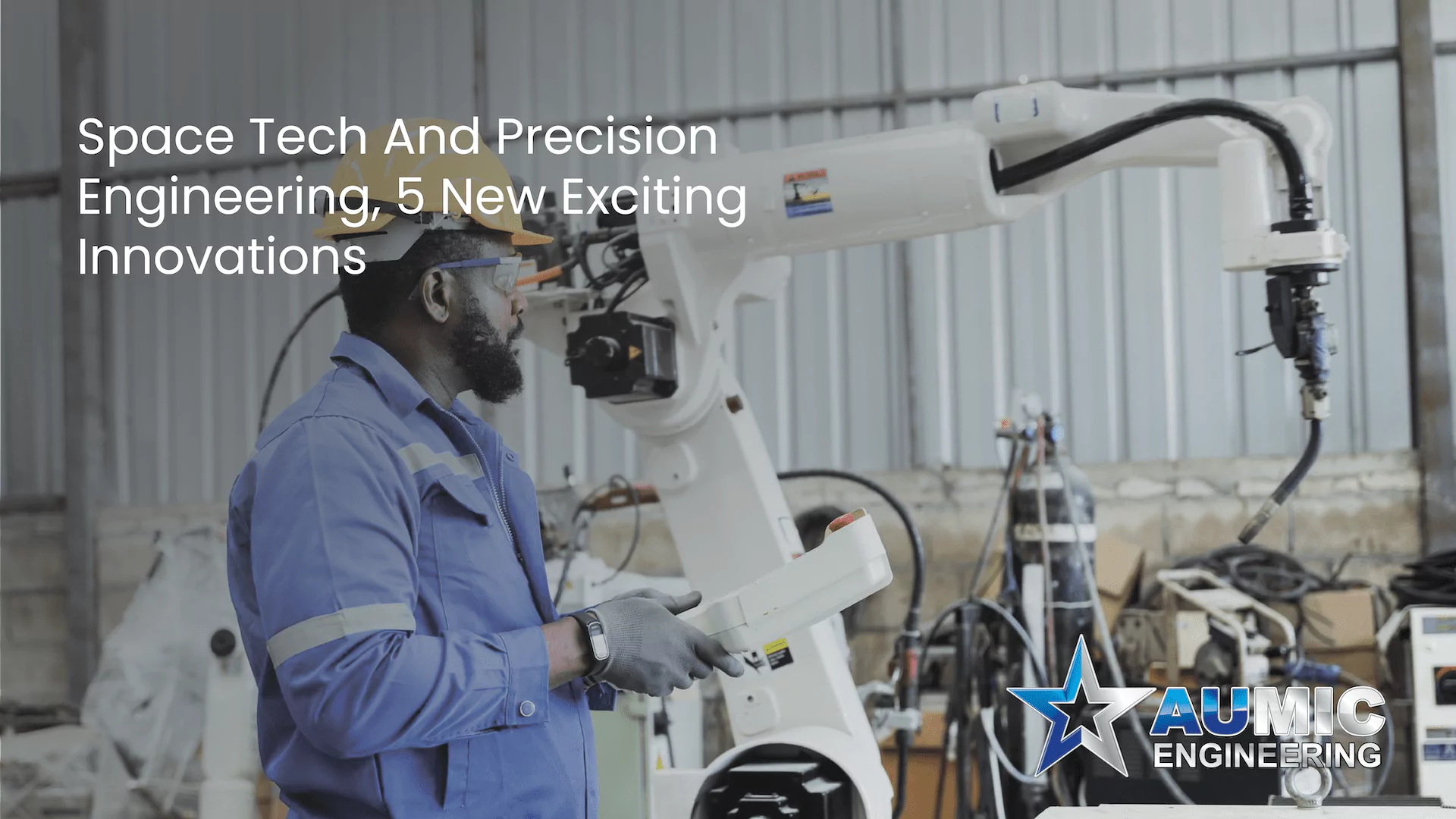Space tech has always relied on precision engineering to push the boundaries of what is possible. As humanity ventures further into the cosmos, the demand for innovative, precise, and reliable engineering solutions grows. Precision engineering is crucial in developing advanced technologies fundamental to space exploration, from building durable satellites to crafting sophisticated navigation systems. These innovations are not just about reaching new frontiers; they are about doing so with accuracy, efficiency, and sustainability.
Precision engineering is the backbone of space exploration, allowing us to navigate vast distances, build components that withstand extreme environments, and solve complex problems with pinpoint accuracy. Here are five exciting innovations at the intersection of space tech and precision engineering transforming how we explore the universe.

1. Ultra-Precise Manufacturing Space Tech For Satellites
One of the most significant advancements in space technology is the development of ultra-precise manufacturing techniques. These innovations enhance satellite performance, durability, and longevity, which are critical given the harsh conditions of space and the high costs associated with launching and maintaining them.
Additive manufacturing, or 3D printing, has emerged as a game-changer. It allows for lightweight, complex, and customised satellite components that are both strong and durable. This technique reduces material waste and production costs, making satellite manufacturing more precise and efficient. Moreover, 3D printing enables on-demand production for rapid prototyping and developing custom parts for specific missions.
For example, companies like Airbus and NASA are using 3D printing to develop parts for satellites that are lighter and more robust, optimising their performance in orbit. These parts range from antennas and waveguides to entire satellite structures. The precision offered by additive manufacturing ensures that each component is crafted to exact specifications, minimising the risk of failure in space. By embracing these new manufacturing techniques, the space industry is pushing the limits of what satellites can achieve, paving the way for more ambitious missions and broader applications.
SpaceX’s Impact On Precision Engineering
Without mentioning SpaceX, modern space tech and precision engineering would be incomplete. Elon Musk’s pioneering space company has revolutionised the aerospace industry with its ambitious goals, innovative technologies, and cost-effective solutions. SpaceX’s development of reusable rockets, such as the Falcon 9, showcases precision engineering at its finest. The precision required to land a rocket vertically after re-entering Earth’s atmosphere is an engineering marvel, reducing costs and making space travel more accessible.
SpaceX’s advancements in spacecraft design, like the Dragon and Starship, have also redefined space missions. The Dragon spacecraft, for instance, is designed with exact systems for autonomously docking with the International Space Station (ISS). At the same time, the upcoming Starship aims to take precision engineering to new heights by enabling human missions to Mars. SpaceX’s focus on precision in every aspect of design, from propulsion systems to launch processes sets new standards for the space industry, pushing the boundaries of what’s achievable in space exploration.
2. Advanced Robotics For Space Tech Missions
Using advanced robotics in space exploration reshapes our understanding of what is possible beyond Earth’s atmosphere. Precision-engineered robots have become essential tools for tasks that are too dangerous, repetitive, or physically impossible for humans. These robots are used in various applications, from the construction of space stations to the repair and maintenance of satellites.
One of the most exciting developments in this field is the creation of highly sophisticated robotic arms and manipulators designed for space environments. These systems can perform complex tasks with extreme accuracy, such as assembling large structures in orbit or capturing and servicing satellites. For instance, NASA’s Robotic Refueling Mission (RRM) uses robotic technology to demonstrate the potential of on-orbit satellite servicing, reducing the need to send costly replacement satellites into space.
These robots rely on high-precision actuators and sensors, which allow them to perform delicate maneuvers and adjustments in zero gravity. The development of advanced robotic systems has also paved the way for ambitious projects, such as building and maintaining habitats on the Moon or Mars. By enabling operations that were once deemed too risky or complex, precision-engineered robotics are crucial in extending human capabilities in space.

3. High-Performance Materials For Extreme Conditions
Space tech exploration exposes materials to extreme conditions, including intense radiation, extreme temperatures, and high-velocity impacts from micrometeoroids. To address these challenges, researchers are developing new high-performance materials that can withstand the rigors of space while providing superior functionality.
Nanomaterials, such as graphene and carbon nanotubes, are at the forefront of this innovation. These materials offer exceptional strength-to-weight ratios, thermal conductivity, and resistance to radiation damage, making them ideal for use in spacecraft, satellites, and spacesuits. For example, graphene coatings can provide superior thermal management for spacecraft surfaces, ensuring that they remain at optimal temperatures even when exposed to the sun’s intense heat or the cold vacuum of space.
In addition, new ceramic and composite materials are being developed to create lightweight but durable shielding against cosmic radiation and micrometeoroid impacts. The precision manufacturing of these materials ensures that every component meets the stringent requirements for space missions, reducing the risk of failure and increasing mission success rates. As a result, these high-performance materials are setting new standards for durability and reliability in the space tech aerospace industry.
4. Precision Navigation And Positioning Systems
Accurate navigation and positioning are critical for the success of any space mission, whether it is guiding a spacecraft to a distant planet or maintaining the precise orbit of a satellite. Recent innovations in precision navigation systems enable new levels of accuracy and reliability, which are essential for complex operations in space.
Innovative technologies like next-generation gyroscopes and accelerometers, are revolutionising spacecraft navigation. These devices use advanced optical and quantum sensing techniques providing unparalleled accuracy in measuring position, velocity, and orientation. For example, cold atom interferometry, a technology based on quantum mechanics, allows for ultra-precise measurements of gravitational fields and motion, which is particularly useful for deep-space navigation where traditional methods are less effective.
Additionally, the development of miniaturised star trackers and light detection and ranging (LiDAR) systems has enhanced the ability of spacecraft to determine their location and orientation in space. This space tech system offers significant improvements in accuracy over older technologies, enabling more precise control during critical maneuvers, such as landing on planetary surfaces or docking with other spacecraft. The advancements in precision navigation enhance mission success rates and pave the way for more ambitious exploration goals.
5. Miniaturised Propulsion Systems
The need for efficient and reliable propulsion systems is more critical than ever, especially with the growing interest in small satellites (smallsats) and interplanetary probes in space tech. Innovations in miniaturised propulsion technologies are providing new opportunities for cost-effective and flexible space missions.
Electric propulsion, in particular, has gained traction as a powerful yet compact solution for small satellites and space probes. This technology uses electric fields to accelerate ions, generating thrust while consuming less fuel than traditional chemical propulsion systems. Recent developments in Hall effect and ion thrusters offer significant improvements in efficiency and longevity, making them ideal for long-duration missions.
By integrating these miniaturised propulsion systems with precise control mechanisms, satellites, and spacecraft can achieve more accurate positioning and maneuvering in space. This capability is essential for missions that require frequent orbital adjustments or complex trajectories, such as satellite constellations for global communication or interplanetary exploration. The advancements in miniaturised propulsion reduce costs and open up new possibilities for space exploration, from deep space missions to commercial satellite networks.

Space Tech And Precision Engineering
The intersection of space tech and precision engineering is driving remarkable innovations that are reshaping our capabilities in space exploration. From ultra-precise manufacturing and advanced robotics to new materials, navigation systems, and miniaturised propulsion, these advancements are setting the stage for the next era of discovery. As space tech continues to evolve, the importance of precision engineering will only grow, providing the foundation for safer, more efficient, and more ambitious missions.
By investing in innovative space tech, companies can position themselves at the forefront of the space industry, leveraging the power of precision engineering to unlock new possibilities in the cosmos.

